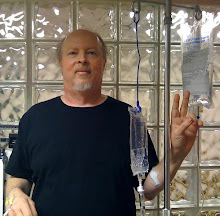Here comes September 3 again, the anniversary of my diagnosis with chronic lymphocytic leukemia. It approaches each year like the garbage truck that groans down the street every Monday morning, screeching, growling, and filling the neighborhood with diesel fumes.
In other words, it’s unpleasant. But it’s made palatable by the fact that I am still here to reflect upon it.
This is my eighth anniversary, and I have the song “Hang on, Sloopy” running through my head. It’s easy to figure out why. If I have any advice to offer as a grizzled veteran of CLL, it’s “Hang on.”
* * *
On some fundamental level I have never accepted that CLL will kill me. It’s a silly disease, all these B cell clones making copies (cue the Richmeister from Saturday Night Live) and clogging up the works. The clones can be killed rather easily, it’s just that it’s nearly impossible to kill every last one. And you can have very good quality of life while living with CLL. Cancer is never good, but on the Bell Curve from Hell, CLL is at the better end.
Call me crazy –- and some of you no doubt will -– but my refusal to accept that CLL is my end is just the sort of wild-eyed faith that cancer patients who beat cancer sometimes have.
So I have spent eight years muddling through, often rejecting the advice of doctors, which is usually conflicting, about what to do.
The choices, until lately, haven’t been very good. One doctor told me to do PCR and “get on with my life.” He was reduced to mumbling when asked what I should do after PCR wore off in two or three years. Another doctor did the obligatory push for fludarabine; after he became assured that I was an adult and not prone to panic, he admitted that well, no, it really isn’t as effective over the long term as it needs to be. I've looked seriously into transplants, which have been advocated by some very reasonable people, and have come away thinking they're too risky on too many levels. (I'd still do one if I had to -- I'd do anything if I had to, except vincristine again -- but I have a very high bar when it comes to defining "have to.") What I'm saying is, scratch the surface of any responsible medical professional and they'll admit that most treatments currently in use have unfortunate limitations.
It can be easy to get swept up in the world of incremental progress that researchers make. But the bottom line is that improvements do not mean that the progress is satisfactory.
So I have waited until I have been forced to act, I have avoided the most potentially damaging options whenever possible, and I have waited some more.
Is this a wise approach? I don't know. It's what works for me. In the absence of a way to win the war, I find it better to sit and wait for the enemy, conducting a guerrilla campaign around the edges, than to go all in and claim a Pyrrhic victory.
* * *
This has come at a cost. No matter how you choose to fight CLL (or choose not to fight it) there are risks. It’s very much a war of attrition, as Terry Hamblin once put it.
This blog is filled with posts about the challenges I have faced. For those of us not “blessed” with indolent CLL, the disease can only get worse over time. Treatment helps, but it also exacerbates the situation by increasing disease resistance. This goes for softer treatments as well as harder ones. Failing to treat when you ought to -– sometimes we need to be proactive -– leads to similar consequences, since the disease will grow and potentially evolve into a worse form just for the hell of it.
In hindsight we can see how things might have been different had we done X, Y, or Z. But in the heat of battle, it is, as they used to say in the military, S.N.A.F.U. You just do your best and hope nothing explodes.
And if you don't choose too badly, if you respond decently to treatment, if your body proves more resilient than not, if a little luck comes your way, you can muddle through.
* * *
After eight years, I see tangible evidence that waiting pays off.
We’re all familiar with the great news from the University of Pennsylvania. Finally, a T cell therapy has been developed that can apparently wipe out the disease, even in cases considered to be hopeless. It’s like having a successful transplant without all the risk. This means the cure, or de facto cure, could be at our doorstep.
I have seen other drugs become available, either officially, or off-label, or in trial. There’s Revlimid, which for some people is a control. CAL-101 and other kinase inhibitors, which are doing well in studies. (I wonder how Revlimid and CAL-101 would work together?) Ofatumumab has been added to the list of options; it’s no panacea, but it helps.
I have also seen some flavors of the month fall by the wayside, notably alemtuzumab. And I have seen opinions change: The 11q deletion, once thought to be the kiss of death, isn’t always so. The point is that the longer we have to learn, the more we know.
So my thought this anniversary is to hang on. The longer you can drag things out, the greater chance that scientific progress will come up with something to save your sorry ass. It doesn’t matter how inelegantly you arrive across the finish line, just so long as you get there.
Eight years later, I’m still at Stage 2. My hemoglobin and platelets have weathered the storm. I’m no more prone to infections than I was when diagnosed. My quality of life is pretty much the same, challenged occasionally by side effects from the Revlimid I'm taking. The disease is definitely bigger and harder to treat, more node-based and less leukemic, but Revlimid is holding the line. (I got lucky with that one; luck is part of the equation, remember.)
I’m basically none the worse for wear. And crazy, of course, as a sack full of otters.
My personal decision to restart my CLL (chronic lymphocytic leukemia)
treatment
-
I have good reasons to believe it is time to re-treat my CLL.
Before deciding on the best therapy choice to treat my CLL/SLL (chronic
lymphocytic leukemia/...
7 months ago







